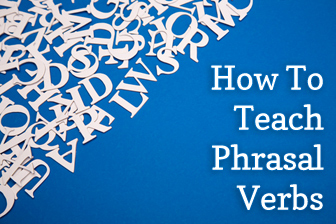How to Teach Phrasal Verbs

![How to Teach Phrasal Verbs [Get]](https://m.busyteacher.org/uploads/posts/2013-11/1383402372_get.jpg)
One little word used in so many ways leaves them confused and at the same time eager to get to the bottom of this: what does this word really mean?
How can we answer this simple question in a way students will really “get”? You can simply launch into a list of the most common uses of this verb. Or you can teach this all-purpose verb (and others!) like this:

One dictionary lists about 20 phrasal verbs with 'get' and another 20 idioms – enough to drive any ESL student up the wall. This is precisely the problem with all-purpose verbs: dictionary definitions are no help at all. The best way to approach a verb like this is to choose five to six uses of the verb. And if possible, you should choose them with a theme. Let’s consider this example: Visiting London. Here you have about a dozen uses of the verb 'get', all surrounding the topic of visiting another city. This is a great group of phrasal verbs to focus on because you can contrast and compare some (get across vs. get through).
I would use the worksheet mentioned above as a review or practice exercise. To introduce a new set of phrasal verbs, I’d first write up a paragraph where these phrasal verbs are used and have my students read it. Then, ask students to guess the meaning of each phrasal verb (the context helps!) and then challenge them to come up with a synonym (for example, get to means to arrive).
If they have a hard time coming up with synonyms on their own, help them out by supplying more examples: I got to school at half past seven this morning. You may also simply introduce them as you would introduce any new vocabulary (by replacing them with a synonym, or substitution, for example), but I believe it is important for students to get into the habit of figuring out phrasal verbs on their own. There are hundreds of them, some of which have more than one meaning. Even if you teach several dozen phrasal verbs every year, they will most likely encounter others that are completely new to them.
You can use any of the worksheets you’ll find here or create your own. Here are just a few ideas for great phrasal verb practice:
Divide your students into pairs and have them write a conversation where they include phrasal verbs with get. Tell them that the pair that uses the most phrasal verbs in a single conversation wins. Walk around the classroom and provide assistance as needed. When all pairs are done, they take turns acting out their conversation to the class. Remember that phrasal verbs are used more often in spoken, rather than in written English. This exercise helps them understand how these verbs sound in a conversation.
One of the best ways to ensure students will remember the phrasal verbs is to expose them to these expressions again and again. So, when you learn a new batch of phrasal verbs review the ones previously seen in class. Also, try to use them as much as possible and encourage your students to do so, as well. For example, if a student says, “I was not able to contact Juan”, you can prompt him/her to use the phrase get through to.
But the fun does not stop here! 'Get' is only one of many verbs that tend to pop up in English conversation. Other useful all-purpose verbs to practice include do, take and put. You may also choose your groups of phrasal verbs to suit a topic like transportation or health. Or you may prefer to choose a group of phrasal verbs with the same preposition, rather than the same verb, like phrasal verbs with out or phrasal verbs with for and on.
The important thing is they have something in common, something that will help students remember them and not confuse them. No matter which group of verbs you choose, providing a context is key. Think of it as a solid foundation upon which they can build their knowledge.
Do you have a specific way of approaching all-purpose words? How do you help your students learn them? Sound off in the comments below!